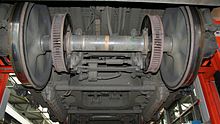Brake hundredths

Braking hundredths (abbreviated Brh or λ ) are dimensionless numbers for evaluating the braking ability of a railway vehicle or a train . The braking percentages used to be called braking percentages and are referred to in Switzerland as the braking ratio . The reference value (basic value) of the braking power expressed as braked weight is historically defined (see history ).
Calculation of brake hundredths
The braking percentages relate the braked weight of a vehicle or train to its mass (weight) in order to compare the braking performance of different trains with their different loads.
To determine the braking percentage, the quotient of the braked weight and the actual weight of the vehicle or train is multiplied by a factor of 100 :
meaning

With the same number of braking percentages and the same type of braking , different vehicles or trains have the same braking distance when braking quickly from the same speed .
These relationships between braking percentages, type of braking, driving speed, braking distance and road gradient are recorded in tabular braking tables . They indicate how many braking hundredths a train must have so that it can safely come to a stop from a certain speed on a certain gradient within the distant signal distance. The brake panels also determine how fast a train can still travel with the braking percentage calculated for it without the braking distance exceeding the distance from the distant signal in the event of rapid braking.
Come to Germany so-called rule braking distances for application to both the distances between pre- and main signals must be designed and the braking ability of trains. They are usually:
- on branch lines 400 or 700 meters depending on the permissible speed
- on main tracks 700 or 1000 meters
The calculated braking percentages are essential for setting the train data for punctual train control . This shows in which train type (O, M, U) the respective train is driven.
Minimum brake hundredth

In Germany , the minimum required braking percentages were specified for each route, which result from the relevant route inclination and the standard braking distance of the permissible route speed. The braking percentages specified in the timetable ensure that the braking distance - usually the distance between the pre-signal and the main signal - is maintained in the event of rapid braking from the highest permitted speed.
If a train cannot meet the minimum braking hundredths (abbreviated Mbr), its speed must be reduced. If z. For example, for a train with 66 brake hundredths at a required maximum speed of 100 km / h, the 1000-meter brake board is to be used as a basis, there is a speed loss of 5 km / h with a significant gradient of 10 ‰, for example.
The Austrian operating regulations stipulate that there must always be enough braking percentages on a train that it can still travel at 20 km / h on the relevant gradient. The minimum braking hundredths are given in the route list and apply to both directions of travel.
The Swiss regulations do not use the term minimum braking percentage. The speed of a train is determined by its train and brake series . If a train cannot drive on a section of the route because the brake row is too low, this is noted in the route table .
history
In 1893 the concept of the braking percentage was introduced into the operating regulations for Germany's main railways . The braking percentage at that time, however, was defined as the ratio of the number of braked axles to the total number of axles of the train, and therefore made no reference to the weights and braked weights of the train.
In 1936 the characteristic curve of the braking decelerations was examined with a composition of 15 passenger coaches , the heaviest and longest train in service at the time . From then on, the braking behavior of this train corresponded to the code number "100 braking hundredths". Based on this, UIC leaflet 544-1 was created, which is decisive for determining the braking performance. Based on the physical law
defined braking percentage and braked weight:
The dimensionlessness of the size of the brake hundredth and also the unit ton for the braked weight are determined by standardization .
See also
literature
- Jürgen Janicki, Horst Reinhard: Rail vehicle technology. Bahn Fachverlag, 2008, ISBN 978-3-9808002-5-9 .
- Lexicon railroad . Transpress VEB Verlag for Transport , Berlin, 1978
References and comments
- ↑ a b c Jörn Pachl: Glossary of System Technology in Rail Transport , accessed on June 26, 2013
- ↑ Implementing provisions for the Railway Ordinance (AB-EBV) DETEC , July 1, 2016 (PDF; 3 MB). AB 52.2 braking force
- ↑ Jürgen Janicki, Horst Reinhard: Rail Vehicle Technology. Bahn Fachverlag, 2008, ISBN 978-3-9808002-5-9 .
- ↑ a b Frank Minde: Fundamentals of Railway Brake Technology (PDF; 144 kB). Minden (Westphalia), 2007
- ^ Austrian Federal Railways : V3. Operating regulation . Vienna, 2005. § 26
- ↑ Implementing provisions for the Railway Ordinance (AB-EBV) DETEC , July 1, 2016 (PDF; 3 MB). AB 76.1.a Driving speed
- ↑ Swiss Driving Regulations (FDV) A2016 Federal Office of Transport (FOT), July 1, 2016 (PDF; 3 MB). R 300.5, Section 3.7 Row of trains and maximum speed
- ^ Centralblatt der Bauverwaltung . XII. Volume, Berlin July 23, 1892, No. 30, p. 319.



